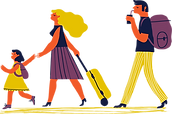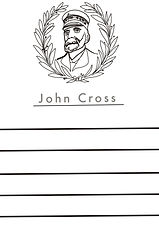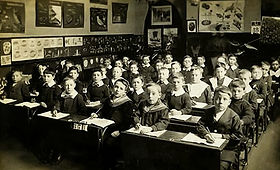PLEASE NOTE THIS PAGE IS UNDER CONSTRUCTION
On this page you will find a collection of useful weblinks and additional resources to support your local history learning and teaching in the classroom after THE HUNT! Resources have been organised into year groups to make things easy for you. Let us know if you would like to see more resources relating to a particular topic and we can see what we can do! Click the pictures or the underlined resource titles to go to the appropriate webpage where applicable.
EYFS
Sarah and Duck: Bugs Button Bank
This episode is a perfect introduction to history for small people. The programme talks about making a collection of old things and using books and research to find out about their origins and historical journey. A must watch for blossoming early historians.
Activities for after: Encourage the children to make their own collection of old things, these could include buttons or rocks. Teachers to provide examples of collections such as old plates from a charity shop or pieces of sea history (see activity below for more details).
Hey Duggee and the History Badge:
Although currently not available on iplayer (keep an eye out though because it's coming up soon, this handy video is on youtube.) It is also currently available on netflix.
Again, it's a good introduction to history in a general sense and follow up activities can include making your own pretend fossil, salt dough dino bones to be hidden and discovered in sand. Links here to local history and geography with the beach on our doorstep. See further activities below.
Old Jack's Boat:
An excellent set of programmes about story telling, one of the keys to historical knowledge. Although the stories are not historically factual in parts, the concept of telling stories from long ago is still a key historical skill.
There are obvious links to literacy and other areas of the curriculum here.
Possible activities could include asking children to tell a story from their past. What memories do you have?
Grow your own Pinapple just like Gladstone's gardener!
FUN FACT! Gladstone used to grow amazing pineapples right here in Seaforth. His gardener was so successful at doing this that it was written about in a book that was read across the UK. Follow this link to find a simple way that you can grow pineapples at home or in class, following in the footsteps of Gladstone. You can grow your pineapple in water for a Science link to looking at roots and the parts of a plant.
Further activities include finding cherry trees in Seaforth. Lots of the cherry trees (there are some just opposite the Emmaus flats outside the school) are as old as Seaforth house and were probably planted around the same time that the house was built. Can you go and find one of these trees? You can identify them by their pink blossoms in sprint and their fruit in Summer, you could even be super detectives and identify them by their bark and leaves in autumn and winter.
.jpeg)
Free History on Crosby Beach!
Crosby beach is right on our doorstep and FULL OF FREE HISTORY! Most of the larger pieces of rubble you will find on the sand are pieces of bombed buildings that were put onto the sand after the war to form sea defences. Children could be encouraged to think about where the items came from. Sea glass may have come from old drinks bottles (all of which were glass not plastic at the time) White glass may be the remains of smashed wartime windows from houses during the blitz. Pieces of tile, brick remnants all pieces of history from a time where buildings were smashed by war or demolished shortly after.
Possible activities could include making treasure chests of finds and talking about where they might have come from.
Children could create art pieces from these finds also, can you draw the artifacts? Can you order them into size order, which ones are big, which are small etc. What shape are they? Describe what details each piece has etc.
HEALTH AND SAFETY NOTE: Please remind children to wash hands after investigating outdoors and to search for treasures with a responsible adult.
.jpeg)
Click the link to download a A4 copy of the mark making and colouring John Cross sheet for use by Nursery 1 and 2.
KS1 please also see EYFS stage resources which may also be useful.


Bitesize Shop Fronts Design
Seaforth used to boast a selection of fabulous shops including some of the ones pictured in the gallery (left). Follow the link to design your own shop fronts, use some of the historical photographs to influence your designs. Click on the title to find the resources. Click on the photo to discover the history of local shop fronts.
Click the link to download the writing frame.
Possible activity: Children could be invited to write a series of sentences describing what they learned about John Cross during the history hunt.
.jpeg)
Free History on Crosby Beach!
Crosby beach is right on our doorstep and FULL OF FREE HISTORY! Most of the larger pieces of rubble you will find on the sand are pieces of bombed buildings that were put onto the sand after the war to form sea defences. Children could be encouraged to think about where the items came from. Sea glass may have come from old drinks bottles (all of which were glass not plastic at the time) White glass may be the remains of smashed wartime windows from houses during the blitz. Pieces of tile, brick remnants all pieces of history from a time where buildings were smashed by war or demolished shortly after.
Possible activities could include making treasure chests of finds and talking about where they might have come from.
Children could create art pieces from these finds also, can you draw the artifacts? Can you order them into size order, which ones are big, which are small etc. What shape are they? Describe what details each piece has etc.
HEALTH AND SAFETY NOTE: Please remind children to wash hands after investigating outdoors and to search for treasures with a responsible adult.
Grow your own Pinapple just like Gladstone's gardener!
FUN FACT! Gladstone used to grow amazing pineapples right here in Seaforth. His gardener was so successful at doing this that it was written about in a book that was read across the UK. Follow this link to find a simple way that you can grow pineapples at home or in class, following in the footsteps of Gladstone. You can grow your pineapple in water for a Science link to looking at roots and the parts of a plant.
Further activities include finding cherry trees in Seaforth. Lots of the cherry trees (there are some just opposite the Emmaus flats outside the school) are as old as Seaforth house and were probably planted around the same time that the house was built. Can you go and find one of these trees? You can identify them by their pink blossoms in Spring and their fruit in Summer, you could even be super detectives and identify them by their bark and leaves in Autumn and Winter.
EXTENSION ACTIVITY: Children could write instructions for how to plant a pineapples and draw a diagram of the working parts of a growing pineapple as it grows in water. Curriculum links with Science and English.
This is a great little resource which is full of information about Liverpool's historic cinemas, theatres and picture houses, many of which are now closed or have been demolished or left derelict and empty. Children could use this resource for simple research, looking at a selection of old films and writing about how things were different then and now in the cinema (do they know that films didn't used to have any sound!?). This could lead into some creative writing where the children create their own silent film scene, describing things only by their movements and expressions to tell the story. This is a great way for children to improve their story telling thinking skills.
Click this link for FACTS about the Paladium Cinema in Seaforth
Click this link for FACTS about the Stella Cinema, also in Seaforth
Here is a great little video of one local's memories of the Palladium, previously known as "the flea pit!"
One of the most popular films shown at the Stella, the children could be invited to write their own dramatically worded poster for one of their favourite films, can they make sure they use words that will make people want to see the film? Curriculum links here with persuasive writing in English. Children could use design technology and different art forms such as photography to create a dramatic and memorable poster (please contact me for more advice if you are interested in this project and I may be able to organise a zoom tutorial for students.)

Currently unavailable on iplayer but keep your eye out for an episode of Sarah and Duck called "cinema scoot" It's all about old fashioned cinema, Sarah and Duck create their own sounds for a silent film to help everyone to understand the story. Two clips of the episode are available below....
See right for clip 2

You're Welcome! : Possibly the best piece of local history, did you know there used to be a toffee factory with a massive chimney just around the corner? Williams of Bootle closed after being bombed and apparently the sweet smell of singed sugar filled the air for weeks after! Children can be encouraged to make marzipan tea cakes to the original recipe and can then design their own boxes using 3D shape constructions. Click on the pictures to find out more information about the factory.
You can find even more information by clicking this link too: https://www.bootlehistory.co.uk/forum/viewtopic.php?t=3743
KS2 please also see KS1 resources which may also be useful.

Make your own Stella Picture House!
Click the title or the picture and scroll down to the bottom of the page to download your own cut out and build Stella Picture House which used to be situated in the Stella Precinct in Seaforth. While you are there, you can research the cinema using the information on the page. Links here with Design Technology.
Click the link to download the writing sheet. Suggested activity, children could be invited to write a first person narrative of one of the tragedies where John Cross was in attendance. Further research can be found in the links below to the Mexican tragedy mentioned in the history hunt video.
John Jackson: Lifeboat survivor.
Following the story of John Cross and the Mexican disaster, the children could be invited to conduct their own research relating to the events of that night. Including the survival of John Jackson. This could lead to some creative writing about the night of the disaster, a newspaper article write where the children report about the events of that evening including an interview with John Cross. It could be used for poetry, chronological writing...the English activities are endless!
Possible art links: Create a relief print of John Jackson, paint a portrait of John Jackson, contact dot rogers for further details of how to do this.
Situated opposite Bowersdale Park to the right of the school, on the corner opposite the Paladium Cinema, used to be the old police station. It is now occupied by modern housing, but the building still echos the Victorian structure that used to stand here. Click the link (the title above) and scroll to the bottom of the page to download the paper engineering model that children can build themselves.
Click the link to see a collection of photos of WW2 bomb damage in Bootle and the surrounding areas.
Possible activities: Children could be encouraged to plot the bomb damage onto a map, marking each place that a bomb fell using the information from the link provided as a guide to bomb locations. Links to Geography mapping skills here.
This link takes you to a great little resource featuring lots of local photographs from a range of historical period. Perfect for individual research by older children or great as a teaching tool for teachers.
We recommend that this resource be used by older children only as it looks at local service men and women who lost their lives while serving in the war. A good research tool, the list of the lost could be used to plot geographical points on a map in the local area, it could also be used as part of a maths statistics project where ages were input into a database to show the trend of those who died. The link for Seaforth and Litherland doesn't seem to work so you can find that information here instead. Names of local service men and women could be used as research starting points where children could be invited to write diary entries etc of those men and women/or pieces of fictional writing or historical accounts of further research around these people. These lists could be used as a starting point for poetry or a piece of artwork of any form. The curriculum links are endless!
Here is a nice little video with Eric talking about his memories of the Stella Picture house and how it was a "little palace". The children could use this as a start of research about the differences between then and now. Perhaps they could watch the Scarlet Pimpernel as an end of year treat (or a tiny bit of it at least! )
Click here for a particularly heart warming set of interviews conducted by local children some years ago. In each interview, local older people are asked questions by children about their memories of growing up in Bootle. Please listen to interviews before playing in the classroom as you may want to edit some bits out!
This link contains fabulous material for first person narrative writing related to the experiences of those interviewed.
Click here for a fabulous resource for local history. This forum is full of local history experts who can answer your every local history question in a trice! They have been extremely helpful to me over the past few months! With what can only be described as impressive local knowledge, they are perfect candidates for potential school interviews (zoom or otherwise) and when lockdown is lifted properly, I think some of them would be more than happy to come and visit the school to be interviewed.
The site also contains a wealth of photographs, videos of interviews with locals and much more. Although I have only seen suitable content on this site, as this is an ever evolving page which is open to the public, we advise that children are not left to search alone but instead under guidance.

















.jpeg)






.jpeg)



%20fr.jpg)


